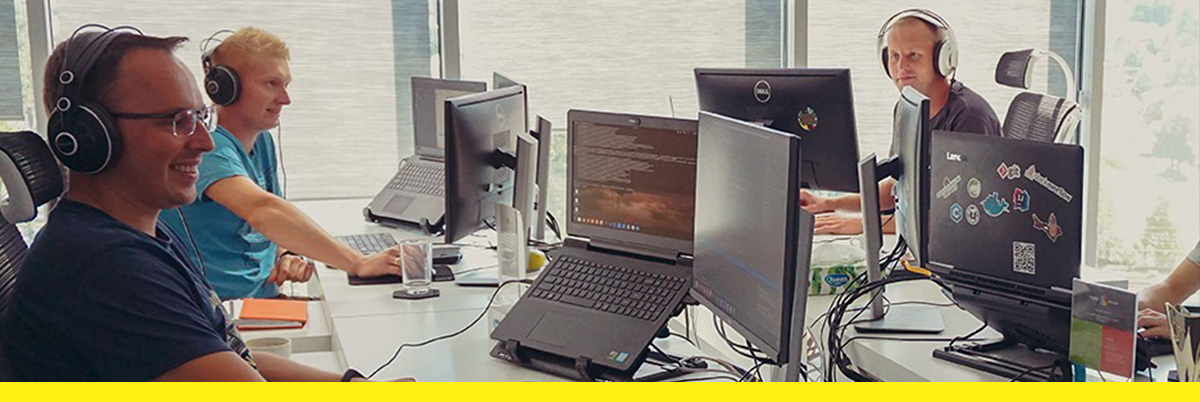Table of Contents
You may have programming needs that your team cannot fulfill. You may hear about software houses offering their services. And you may ask yourself, „What’s all that about?”
We’re aware that this may sound like blunt self-promotion, but it’s not quite that. Regardless of which software house you want to start a relationship with, there are things you can expect. Certain quirks of the collaboration, that you should perhaps be aware of to make your work go more smoothly. And, most of all, you might be wondering if this is even worth the effort. We’re here to answer.
Should you outsource your IT projects to a software house?
This depends entirely on your approach to the project. The good (or, possibly, the bad) thing about outsourcing is that you don’t have the programmers at the office. So if that is important to you, then probably you should reconsider, or at least choose a team located nearby.
Then, there’s the matter of money. Here, you definitely save. Hiring a software house for a specific project is way cheaper than creating your own team from the scratch. You also don’t have to worry about purchasing all the software licenses for your people.
Outsourcing will most likely also speed up the entire endeavor since you’re getting a service from the people who specialize in this kind of work. They already have all the processes in place. And they have knowledge and experience they can apply.
However, you can choose multiple models of cooperation with a software house. Let’s take a closer look at these, shall we?
The models for IT outsourcing
Staff Augmentation / Body Leasing / Dedicated Teams

This mode of cooperation lets you add members to an existing IT team to support it in pursuing a specific goal, or for a specific time. Your temporary hires take over some duties while bringing the experience of their studio.
Advantages:
- It’s a quick win. You need more people, you have more people. Immediately.
- You save time and money by avoiding the headhunting process.
- You’re not bound by any long-term contract. You can easily let go of the new people when you no longer need them.
Before you try:
- You should know what exactly the new people are needed for. Give them clear goals and expectations, and be ready to manage the stages of their work.
- Your new personnel will still need some kind of introduction into your company and their team…
- This model becomes expensive in the long run, so use it only for short-term projects.
- More hands-on board may not be the best solution in some cases.
Project Outsourcing
In this model, you hire an entire IT team for a specific project. What you get is a comprehensive service, where all you need to do is to explain what you expect, and to what purpose. A team of programmers, project managers, QA, or UX/UI specialists will take care of it. You can also have your people working closely with this external team in order to share knowledge and widen your people’s horizons.
Advantages:
- Most of the responsibilities are handled by your partner, making the project less stressful and resource-consuming.
- You save time and money you’d have to spend on all kinds of HR activities, including onboarding and training.
- You know what to expect. You get a roadmap with deadlines.
- Using an external talent pool may give life to new ideas you wouldn’t have come up with on your own.
- You can use this as an opportunity for your people to observe and learn.
Before you try:
- An outsourced project isn’t very flexible, since you establish the goals and the terms at the start of your cooperation.
- While you have your input in the project, your control over it is limited. That’s why it’s important to find a trusted and experienced partner. One who will make all the right decisions.
- This model works best for projects that take the attention away from your company’s primary domain.
Full-cycle software development services / Custom IT Solutions
This process usually produces software with the highest quality, at the lowest cost, in the shortest time. The IT partner commits to develop your business idea and bring it to the market. You get the full range of services, starting from business consultancy, advising on tech implementation and developing a proof of concept, and finishing with rolling the ready-made product to the market, maintaining and constantly approving it.
Advantages:
- You get the full range of services, from business consultancy to implementation advice to a proof of concept and the finished product.
- You can fully customize your product.
- It’s a combo of analytical and consultancy skills with a full-cycle development.
- It’s usually the most cost-effective.
Before you try:
- It’s an untraditional model, hence your constant involvement is key. Both the client and the IT partner need to cohesively work on the project goals as one team.
Pricing: Time & Material vs. Fixed Price
Selecting the right contractual arrangement is vital. The consequences of a wrong choice may be harsh – you could go through much hassle and end up without a finished product. So how to settle with an IT company?
Time & Material
Time and material contracts involve billing clients for exactly what they get. With a time and material contract, you are charged a set hourly rate for all labor along with the costs of materials.
Fixed Price
A fixed-price contract involves an agreement that explicitly defines the services along with a set price for the entire project. We wrote about it in detail here.
At fireup.pro, we usually implement the time and material model. This type of pricing structure best suits agile development, which is definitely our thing. Labour and material billing structure foster a communicative environment, which will ensure that you get the most.
You may indeed pay more to have quality work get done. But in the end, it will probably be a lot less than what you’ll end up paying if you develop a product of poor quality. Plus, by participating actively in the project—you will be able to help guide and direct it. This will help minimize any significant differences from the estimates. You can also modify the scope of the project as you move along.
When selecting the type of contract, you should know that we have never had a project where nothing changes during the development phase. It is important to understand the dynamic nature of software development. When you know things are going to change, you are being prepared. And being prepared is what you agree to in a time and materials contract.
So, to sum it up:
How to choose a software house cooperation model?
You should base your decision on the following factors.
- Budget
- Project scope (known vs. Unknown)
- Estimated time frame
- Technical innovation level
- Preferred management method
- Need for scalability
Remember that you don’t have to rely on just a single outsourcing model. Even if you work with just one software house. Most IT companies are flexible when it comes to terms of cooperation. In most cases, you can choose a hybrid model, such as T&M with a monthly hour limit.
What’s important, you shouldn’t lose your focus on what the ultimate goal of this settlement is. At fireup.pro, we focus on improving the product quality, the work comfort, and the business of our client. For all of the above, the first stage is crucial. We need to establish good communication, learn about the key business goals, and set the proper priorities. Is this possible considering the remote nature of our work? Yes, it is. We are remote but agile, and we encourage our customers to adopt agile methods for increased business value, transparency, and productivity.
If you’re interested, you can learn more about the agile approach HERE.
